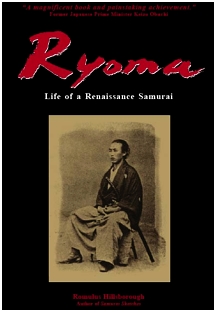
Ryoma: Life of a Renaissance Samurai
(The classic biographical novel of Sakamoto Ryoma, the only one in the English language.)
A magnificent book and painstaking achievement. — Former Japanese Prime Minister Keizo Obuchi
#61 on “The 100 Best Historical Novels of All Time” (from List Muse)
The founder of Japan’s first modern corporation was a swaggering swordsman who packed a Smith and Wesson, an outlaw who led a band of samurai to overthrow the shogun, and one of the most colorful figures in Japanese history. His name was Ryoma, which is the title of the only biographical novel in English about this charismatic leader of the samurai revolution (i.e., Meiji Restoration).
Mid-19th-century Japan was a caldron of political upheaval and intrigue, bloody inner-fighting among samurai, and the end of two and a half centuries of rule under the shogun. This most enthralling age in the annals of Japan brought forth some of the most fascinating men in that nation’s history. Those men modernized Japan, and laid the foundation for the militarism of WWII and the economic powerhouse of today. This close look into the hearts and minds of those two-sworded men provides a deep insight into the political, cultural, and psychological roots of modern Japan.
The book is divided into three parts. Part I deals with Ryoma’s formative years. He travels to the shogun’s capital at Edo to study fencing. Here he witnesses the shocking appearance of Perry’s flotilla of warships in the summer of 1853. The young swordsman is awakened to the bitter reality that the Western threat cannot be dealt with by samurai spirit alone. He realizes that Japan must import Western technology to survive in the modern world, and becomes disgusted with the backward and repressive feudal system.
Part II begins in the year 1861. Ryoma is determined to overthrow the shogun. To achieve this, he flees his native domain, one of the most serious crimes a samurai can commit. Now an outlaw, he meets Katsu Kaishu, the shogun’s brilliant naval commissioner. The elite government official takes the outlaw under his wing, greatly influencing Ryoma’s life and the future of Japan. Ryoma helps Katsu form a naval academy, where he and his band of revolutionaries gain expertise at navigating state-of-the-art steamships. This is a period of assassination and turmoil, set in the Imperial capital of Kyoto, Edo and elsewhere.
Part III chronicles Ryoma’s key role in overthrowing the shogun. Ryoma and his men are in danger of arrest. They are protected by the leaders of the powerful Satsuma clan. Through Satsuma’s help, Ryoma and his men acquire a ship, with which they start their own trading company. They purchase foreign guns to arm the Choshu clan, which is at the vanguard of the revolution. Ryoma brokers a military alliance between Satsuma and Choshu as a means to overthrow the government. He is now one of the most wanted men on the shogunate’s long list of enemies. He is nearly killed in a surprise-attack by a police unit at an inn near Kyoto, but fights his way out with a pistol, after being helped by a young maid who later becomes his wife. In the last year of his life, he founds a trading company which is the precursor of the Mitsubishi. He now realizes that the best way to overthrow the shogun is not through bloody civil war, which would invite foreign attack, but through diplomacy. The outlaw who has never held an official post pens a plan by which the shogun peacefully relinquishes the reins of government to the heretofore powerless Emperor. The plan calls for a union of all the feudal clans under the Imperial banner to form a conciliar government inspired by American democracy.
Ryoma is assassinated on the night of his thirty-second birthday, shortly after devising the blueprint for the first modern government of Japan.
